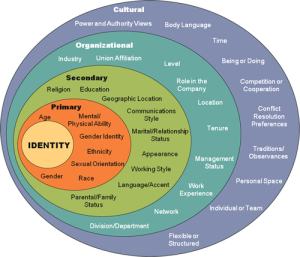What do we mean when we talk about diversity? Merriam-Webster online’s first definition is “the quality or state of having many different forms, types, ideas, etc.” Not bad. Not bad at all. How about the second definition? It’s presented as “the state of having people who are different races or who have different cultures in a group or organization.”
I find this second definition somewhat troublesome and simplistic, in large part because I think a large percentage, if not an overwhelming majority, of people think of diversity in a very limited form. In my experience, within organizations — i.e. enterprise-size businesses — race, ethnicity, physical ability, and gender are about the only classifications in which “diversity” is interpreted to matter. This in spite of definitions that suggest far more inclusiveness, like this one from the University of Oregon’s website:
The concept of diversity encompasses acceptance and respect. It means understanding that each individual is unique, and recognizing our individual differences. These can be along the dimensions of race, ethnicity, gender, sexual orientation, socio-economic status, age, physical abilities, religious beliefs, political beliefs, or other ideologies. It is the exploration of these differences in a safe, positive, and nurturing environment. It is about understanding each other and moving beyond simple tolerance to embracing and celebrating the rich dimensions of diversity contained within each individual.
Getting back to M-W’s first definition. Although it only mentions different forms, types, and ideas, it does manage to throw in an “etc.”, thereby inviting us to expand on the inclusiveness of its meaning. Here’s where I’d like to see a little more creative (and empathetic) thinking about diversity.

This graphic shows similar information regarding diversity, but only breaks it out into two dimensions
For instance, a few simple areas in which we find diversity that aren’t usually thought of as important are: handedness, learning style, personal style, interests and hobbies, hair length and type, gregariousness, public speaking ability, etc. Without belaboring the subject, I’m sure I could come up with dozens of other ways in which we find “diversity”. As the University of Oregon’s definition states, “. . . each individual is unique . . .”.
Isn’t it time we started treating people in terms of the larger context of their lives and experiences, rather than categorizing them — somewhat restrictively — in just a few, largely useless boxes? I’m not suggesting the categories we’ve been using are completely useless, merely that they’re terribly restrictive and overly broad. What’s your opinion? There should be quite a few out there. 😉


August 31st, 2021 at 5:27 pm
[…] I found this bulleted list and the graphic (which can be found on Rick Ladd’s blog post, Do We Fully Understand Diversity?) very helpful for framing the conversation and discussion. (click for a larger version of the […]
LikeLike
September 2nd, 2021 at 6:44 pm
Thank you for sharing this graphic and my post. For the record, I did not create either of the two graphics I used in this post.
LikeLike
March 26th, 2018 at 3:17 am
[…] R., 2014. Do We Fully Understand Diversity?. [Online] Available at: https://rickladd.com/2014/03/24/do-we-fully-understand-diversity/ [Accessed 10 February […]
LikeLike
September 18th, 2015 at 9:11 am
I every time spent my half an hour to read this website’s articles
every day along with a mug of coffee.
LikeLike
March 28th, 2014 at 3:38 pm
Reblogged this on Framework 21.
LikeLike